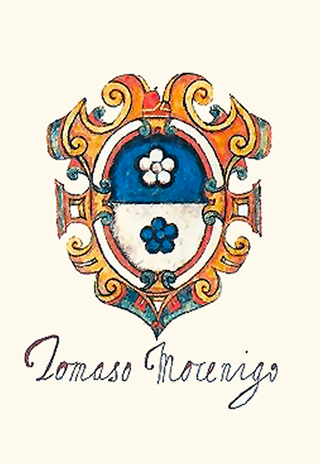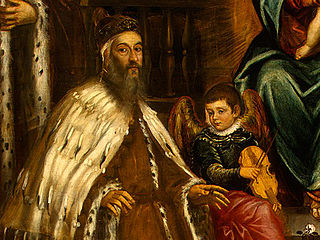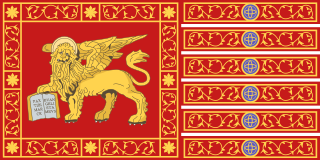
The Battle of Lepanto was a naval engagement that took place on 7 October 1571 when a fleet of the Holy League, a coalition of Catholic states arranged by Pope Pius V, inflicted a major defeat on the fleet of the Ottoman Empire in the Gulf of Patras. The Ottoman forces were sailing westward from their naval station in Lepanto when they met the fleet of the Holy League which was sailing east from Messina, Sicily.

John of Austria was the illegitimate son of Charles V, Holy Roman Emperor. Charles V met his son only once, recognizing him in a codicil to his will. John became a military leader in the service of his half-brother, King Philip II of Spain, Charles V's heir, and is best known for his role as the admiral of the Holy League fleet at the Battle of Lepanto.

The Holy League of 1571 was arranged by Pope Pius V and included the major Catholic powers of southern Europe, specifically the Spanish Empire as well as the Italian maritime powers. It was intended to break the Ottoman Empire’s control of the eastern Mediterranean Sea and was formally concluded on 25 May 1571. Its members were:

The Contarini is one of the founding families of Venice and one of the oldest families of the Italian Nobility. In total eight Doges to the Republic of Venice emerged from this family, as well as 44 Procurators of San Marco, numerous ambassadors, diplomats and other notables. Among the ruling families of the republic, they held the most seats in the Great Council of Venice from the period before the Serrata del Maggior Consiglio when Councillors were elected annually to the end of the republic in 1797. The Contarini claimed to be of Roman origin through their patrilineal descendance of the Aurelii Cottae, a branch of the Roman family Aurelia, and traditionally trace their lineage back to Gaius Aurelius Cotta, consul of the Roman Republic in 252 BC and 248 BC.
This is the order of battle during the Battle of Lepanto on 7 October 1571 in which the Holy League deployed 6 galleasses and 206 galleys, while the Ottoman forces numbered 216 galleys and 56 galliots.

The House of Mocenigo was a Venetian noble family of Lombard origin. Many of its members were doges, statesmen, and soldiers.

Marcantonio Barbaro (1518–1595) was an Italian diplomat of the Republic of Venice.

The Barbaro family was a patrician family of Venice. They were wealthy and influential and owned large estates in the Veneto above Treviso. Various members were noted as church leaders, diplomats, patrons of the arts, military commanders, philosophers, scholars, and scientists.

Sebastiano Venier was Doge of Venice from 11 June 1577 to 3 March 1578. He is best remembered in his role as the Venetian admiral at the Battle of Lepanto.

Giovanni Andrea Doria, also known as Gianandrea Doria, (1539–1606), was an Italian admiral from Genoa.

Marco Antonio Bragadin, also Marcantonio Bragadin, was a Venetian lawyer and military officer of the Republic of Venice.

There were four Doges, and many other prominent Venetians, called Alvise Mocenigo. Alvise I Mocenigo was doge of Venice from 1570 to 1577.

The Fourth Ottoman–Venetian War, also known as the War of Cyprus was fought between 1570 and 1573. It was waged between the Ottoman Empire and the Republic of Venice, the latter joined by the Holy League, a coalition of Christian states formed under the auspices of the Pope, which included Spain, the Republic of Genoa, the Duchy of Savoy, the Knights Hospitaller, the Grand Duchy of Tuscany, and other Italian states.

The siege of Famagusta happened in Venetian-controlled Famagusta, the last Christian possession in Cyprus. Famagusta fell to the Ottomans in August 1571 after a siege that lasted nearly a year.

The island of Cyprus was an overseas possession of the Republic of Venice from 1489, when the independent Kingdom of Cyprus ended, until 1571, when the island was conquered by the Ottoman Empire.
The Bailo of Corfu was the leader of the Venetian delegation to the island of Corfu who oversaw the affairs of the island while under Venetian rule and protected the commercial and military interests of the Republic of Venice. The first mention of a bailo in Corfu is in 1386 and is found in a Greek chronicle. The bailo of Corfu is also mentioned in a document by historian Marco Guazzo from 1544.

The Captain General of the Sea was the wartime commander-in-chief of the Venetian navy.

The Provveditore Generale da Mar was the most senior peacetime office in the Venetian navy and in charge of governing the Venetian overseas empire.
The anti-Ottoman revolts of 1567-1572 were a series of conflicts between Albanian, Greek and other rebels and the Ottoman Empire during the early period 16th century. Social tensions intensified at this time by the debilitation of the Ottoman administration, the chronic economic crisis, and arbitrary conduct of the Ottoman state authorities. The leaders of the uprisings were initially successful and controlled several strategic locations and fortresses, especially in Epirus, Central Greece, and the Peloponnese. However, the movement lacked the necessary organization. They were instigated and assisted by western powers; mainly by the Republic of Venice, and the victory of the Holy League against the Ottoman fleet in the Battle of Lepanto, in November 1571, triggered further revolutionary activity. However, Venice withdrew its support to the rebels and signed a unilateral peace with the Ottomans. As such the rebellions were doomed to end and the Ottoman forces committed a number of massacres in the aftermath of the revolt during the suppression of the uprising. Throughout the pacification process, various primarily isolated areas were still out of Ottoman control and new rebellions erupted, like that of Dionysios Skylosophos in 1611.
This is an alphabetical index of people, places, things, and concepts related to or originating from the Republic of Venice. Feel free to add more, and create missing pages.














